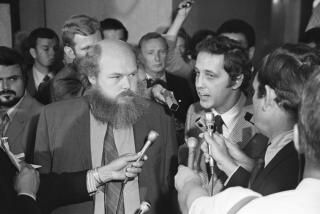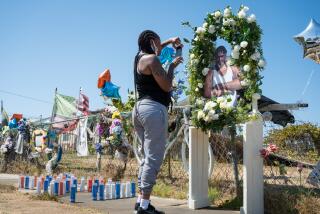Ysmael Parra; Defendant in ‘Sleepy Lagoon’ Trial
Ysmael Parra, a defendant in one of the darkest chapters in Los Angeles court history, the “Sleepy Lagoon” murder case, has died. He was 82.
Known as “Smiles,” Parra died Feb. 23 in Richmond, Va., of complications from Alzheimer’s disease, it was reported to The Times last week.
With his passing, only a few survivors remain among the 12 young men unjustly convicted of murder in the 1942 case.
In all, 22 defendants were tried en masse in the case. Historians consider the trial a product of overzealous prosecutors and a biased judge in an era when prejudice against Mexican Americans was widespread.
The murder convictions were later reversed, but not until the dozen men had served 21 months in prison. The trial would change forever the lives of Parra and the other defendants, whose story was later told--with some fictional embellishments--in the Luis Valdez play and film “Zoot Suit.”
Parra was 22, married with a young daughter and working in a metal shop at the time of his arrest. He had grown up near 38th Street and Long Beach Avenue, south of downtown, and had “hung out” with his neighborhood buddies, his friend Henry Ynostroza recalled last week.
On Aug. 1, 1942, some neighborhood youths went swimming at a reservoir near the intersection of Slauson and Atlantic avenues. They said they were “set upon” by a rival gang, known as the “Downey Boys.” After a fight, the 38th Street youths went home for reinforcements.
Among those who returned to the reservoir were Parra and Ynostroza. When they arrived, Ynostroza said, the area was deserted, but they heard music from a party at an adjacent ranch. They crashed the fiesta, and a fight broke out.
A day or two later, they were surprised to hear that Jose Diaz, a young Mexican national, had been found dead at the ranch. Authorities rounded up hundreds of young men and women. Among those seized were members of the 38th Street gang, including Parra and Ynostroza.
No evidence was found linking any of the men to Diaz’s death. The prosecutors’ case was circumstantial at best: The men had been in the vicinity that night.
At a grand jury investigation, a Sheriff’s Department official presented what purported to be a biological basis for men of Mexican origin to tend toward violence. Sheriff’s Capt. Edward Duran Ayers said “the Mexican element” has an inbred “desire to use a knife or some lethal weapon. In other words, his desire is to kill, or at least, let blood.”
Twenty-four young men from the 38th Street neighborhood were indicted. However, only 22, including Parra and Ynostroza, came to trial in a highly unusual joint proceeding.
The men, confined to County Jail, were not allowed to cut their hair and had to wear the same clothes for the first month of the trial, said activist Alice Greenfield McGrath, who observed part of the trial and later became executive secretary of the Sleepy Lagoon Defense Committee.
At the trial, Judge Charles W. Fricke forbade the defendants from sitting next to their lawyers, as is customary. The defendants were forced to sit together in a so-called prisoners’ box, facing the all-white jury.
Defense attorneys objected to the seating arrangements and to the judge’s insults directed at them. They gave notice that they would ask an appellate court to review what they considered Fricke’s misconduct.
Jurors went home every night and were able to read press accounts of the case. One reporter dubbed the reservoir the “Sleepy Lagoon,” and the case soon became known by that name, the title of a song by trumpeter Harry James.
Articles on juvenile delinquency singled out Mexican American pachucos or gang members. The most stinging criticism was reserved for pachucos who wore the stylish zoot suits.
Because of the press outcry, “public opinion was clearly on the side of the prosecution,” historian Manuel G. Gonzales wrote in his book “Mexicanos.” “Nor did it help that the judge . . . had concluded that the gang was guilty beforehand and prejudiced the case in a number of ways.”
After a 13-week trial, the jury returned mixed verdicts. Three men were found guilty of first-degree murder. Nine others, Parra and Ynostroza included, were convicted of second-degree murder. The dozen men were later sent to San Quentin Prison. Five other defendants were convicted of assault, and five were acquitted.
“It was very heartbreaking to see ‘Smiles’ go to prison,” said his sister, Jane Randall, who now lives in Hawthorne.
At San Quentin, “ ‘Smiles’ was our oldest one and kept us out of trouble,” said Ynostroza, who was 17 when he was convicted. “He would tell us: ‘Straighten up, we have an appeal going. We can’t get into any trouble.’ ”
Activists formed the Sleepy Lagoon Defense Committee, and its lawyers appealed the case. They argued that the defendants had been denied due process rights by Fricke’s rulings.
The state Court of Appeal threw out the convictions in October 1944. In a landmark 121-page decision, the court cited a lack of evidence to establish guilt. The justices also assailed some of Fricke’s actions during the trial, including the unusual seating arrangements and his disparaging comments about the defense lawyer The appellate court said it found “no valid argument for depriving a defendant of . . . his right to the effective and substantial aid of counsel at all stages of the proceeding. To do that . . . is not to proceed promptly in the calm spirit of regulated justice, but to go forward with the haste of a mob.”
The efforts to reverse the convictions had mobilized the local Mexican American community and brought wide support from entertainers and union workers throughout the state.
“For the first time in the memory of the living, Mexicans had won a major round in the courts,” wrote Carey McWilliams, national chairman of the defense committee and later editor of The Nation magazine.
Parra and the other men returned to Los Angeles and were released when the district attorney’s office decided not to seek a new trial.
When Parra was set free, “my mother said he looked so different,” said his daughter, Rita Bearden, now of Stafford, Va. “He kept to himself. He never trusted the police again and lost respect for the law. He was devastated.”
Parra went back to his job chroming bumpers at a plating shop. He got divorced in 1949, later remarried and moved to Arizona, where he helped his father run a rock and gem store. He learned to make Southwestern silver jewelry.
The 6-foot-1 Parra was a serious man, but he had a dry sense of humor, Bearden said. He had wide smile and, until struck by Alzheimer’s, loved to play the guitar and sing.
He moved to Virginia five years ago to be near his daughter.
In the late 1970s, Parra went to a “Zoot Suit” performance at the Aquarius Theater in Hollywood and, at an intermission, encountered McGrath.
“Smiles” had tears in his eyes, she recalled, and he said to her: “When this was happening to us, I knew how awful it was. But until I saw this play, I did not know how sad it was.”
Parra is survived by three children and six brothers and sisters.
More to Read
Sign up for Essential California
The most important California stories and recommendations in your inbox every morning.
You may occasionally receive promotional content from the Los Angeles Times.










